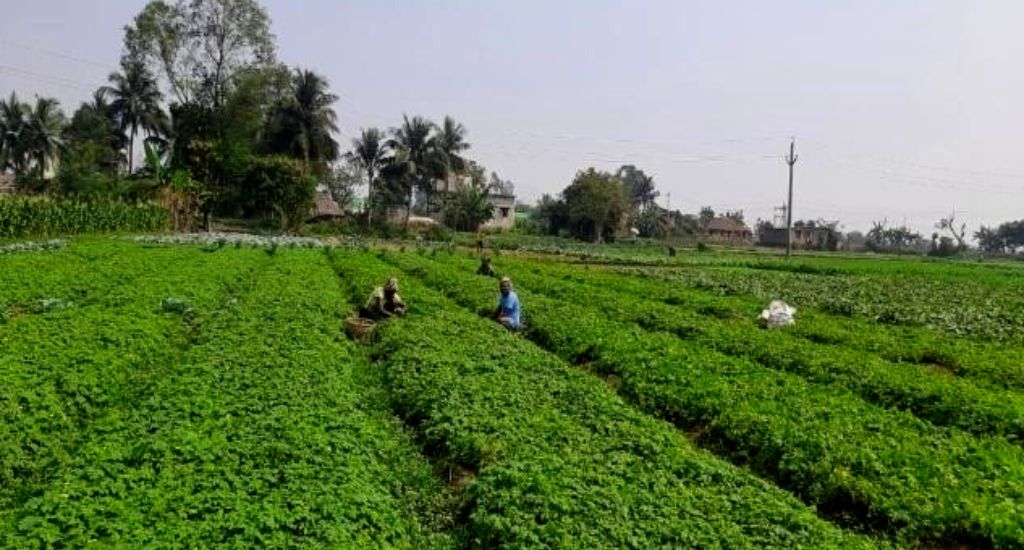
Synchronised farming, collective marketing boost farmers’ income in Odisha
Farmers in an Odisha village are reaping rewards from synchronised cultivation and coming together as a collective for purchase and sale of their produce.

Farmers in an Odisha village are reaping rewards from synchronised cultivation and coming together as a collective for purchase and sale of their produce.
Households in Hatadihi, a village in the Keonjhar district of northern Odisha, earn their livelihood mainly from agriculture and allied activities. Vegetable farming is most popular in the region, and the majority of farmers cultivate their holdings independently.
Farmers procure their inputs and sell their produce in the local markets itself. Distress sale of produce is common which often leads to severe losses for the farmers.
But, this is changing and how. Thanks to synchronised farming and collective marketing farmers in Hatadihi are becoming more prosperous and financially independent. The model – introduced to the farmers with the help of Harsha Trust – is replicable in varied geography and conditions.
Functioning as a group is key to synchronised farming and collective marketing as it facilitates bulk production and sales. Besides aiding in negotiating better prices, bulk sales significantly reduce business costs.
In November 2021, Keonjhar’s Agriculture Production Cluster (APC) started to work towards ensuring collective product selection, inputs procurement, nursery preparation and harvesting, which are essential steps for synchronised farming. Financial support for the intervention was provided by the District Mineral Foundation (DMF).
Across seven gram sabhas of Hatadihi, over 120 self-help groups (SHGs) were used to create 25 producers’ groups, each with 100 members. Eventually, around 100 acres of veggies would be grown on each group’s land.
A common orientation was held for all members of the SHGs, most of whom are tribal women farmers. They received training on the subjects of cropping intensity, productivity enhancement, fair price and agro-climate suitability.
From each group key farmers were identified to visit nearby markets in Chhenapadi, Bhadrak and Jajpur districts. After doing their research on market demand, price and different traders, they reported their findings to the group.
Based on their findings, farmers selected four crops – pointed gourd (parwal), brinjal, bitter gourd (karela) and ridge gourd (turai).
Inputs like seeds, pesticides and fertilisers are procured collectively under this method. Agri entrepreneurs and farmers perform these functions together. After farmers share their requirements with the entrepreneur, quotations from various vendors are collected. The trader who offers the lowest bid is asked to supply the inputs.
Also Read | Tribal women of Sundargarh make organic farming a life-changing economic activity
The farmers also prepare a collective nursery ensuring timely distribution of quality seedlings. The group is divided into smaller sub-groups for monitoring the nursery, preparing seed-bed, seed sowing, irrigation, weeding and application of bio-fertilisers.
Harvesting is done collectively too. These steps reduce labour and transportation costs leading to better profit margins for the farmers.
Harvesting is only the beginning. The challenges of post-harvest management, selection of trader and appropriate market, packaging and trading, and price bargaining remain to be sorted.
Post-harvest management constitutes an inter-disciplinary system applied to agricultural commodities after harvest for the purpose of preservation, conservation, quality control and processing, packaging, storage, and distribution.
In the collective marketing model, the farmers are themselves involved in the process. Based on the market study conducted by them, output is sold to different traders.
Finally sorting, grading and packaging is done as per the requirements of different traders. Using this model, farmers produced a whooping 41.3 tonnes of vegetables and earned a revenue of Rs 10.65 lakh last year.
The farmers in Hatadihi are getting better prices for their harvest since the intervention was made. The time taken in procuring inputs and selling the produce has also been reduced drastically for individual farmers.
While farmers could earlier sell only in one market (Chhenapadi) with limited scope for price negotiation, now they access markets in Bhadrak, Jajpur and Rourkela districts. Accessing new markets has also brought new, rewarding opportunities.
Not only has it reduced distress selling and wastages, it has also helped farmers build sustainable relationships with the traders and access credit.
Also Read | After defeating Posco, farmers turn to reclaim betel leaf economy
The experiences in Keonjhar strongly suggest that synchronisation and collective marketing can boost household income of the farmers. Along with advantages for the individual farmers, cooperating as a group improves farming practices and community-based functions.
The model is highly replicable, promising to benefit many farmers across the country in future.
In the lead image SHGs are oriented towards synchronised farming and collective marketing.
Raghunath Panda works as a team leader at Harsha Trust in Keonjhar, Odisha.